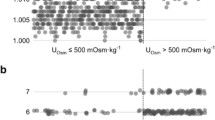Summary
We evaluated the utility of chloride titrator sticks for facilitating the assessment of dietary salt intake, in a systematic series of clinical trials. These inexpensive devices were applied daily to 24-h or nocturnal urine specimens, thereby avoiding the inter- and intra-subject variability in salt excretion which confounds the use of occasional 24-h urine collections. Chloride and sodium concentrations in urine were highly correlated (r>0.92) in either nocturnal, diurnal, or 24-h collections. The quantitative chloride titrator estimates and measured chloride concentrations were highly correlated as well (r>0.99). The qualitative chloride titrator was graded on a simple scale, and was successfully employed by outpatients attempting to limit their salt intake. Commonly used antihypertensive medications did not interfere with the determinations. Additional chloride intake, such as supplemental potassium chloride, interfered with estimates of salt ingestion, but if the daily amount of potassium chloride supplement was constant, adjustments in interpretation could be made. Renal insufficiency introduced a systematic over-estimation of salt intake by the qualitative chloride tirator, but only at high salt intakes. Relative estimates of salt intake in subjects with renal failure were still possible. We conclude that chloride titrators can facilitate the management of patients who require a prescribed salt intake.
Similar content being viewed by others
Abbreviations
- SEM:
-
standard error of mean
- UNaV:
-
urinary sodium excretion
References
Allen FM (1925) Treatment of kidney diseases and high blood pressure. The Newark Printing Co, Newark, NJ, pp 79–82
Ambard L, Beaujard E (1904) Causes de l'hypertension arterielle. Arch Gen Med 1:520
Beard TC, Cooke HM, Gray WR (1982) Randomized controlled trial of a no-added sodium diet for mild hypertension. Lancet 2:455–458
Bryant JM, Iob V, Phillips GL, Blecha EE (1949) Estimation of urinary sodium. JAMA 140:670–672
Cooper R, Liu K, Trevisan M, Miller W, Stamler J (1983) Urinary sodium excretion and blood pressure in children: absence of a reproducible association. Hypertension 5:135–139
Cooper R, Soltero I, Liu K, Berkson D, Levinson S, Stamler J (1980) The association between urinary sodium excretion and blood pressure in children. Circulation 62:97–102
Earley LI, Daugherty TM (1969) Sodium metabolism. N Engl J Med 182:76–86
Fantus B (1936) Fluid postoperatively. JAMA 107:14–17
Freis ED (1976) Salt, volume and the prevention of hypertension. Circulation 53:589–595
Harrington JT, Isner JM, Kassirer JP 1982 Our national obsession with potassium. Am J Med 73:155–159
Kurtz TW, Morris RC (1984) Dietary chloride can be a determinant of desoxycorticosterone hypertension in the rat. Science 222:1139–1141
Levin DM, Cade R (1965) Influence of dietary sodium on renal function in patients with chronic renal disease. Ann Intern Med 62:231–245
Liu K, Cooper R, McKeever J, McKeever P, Byington R, Soltero I, Stamler R, Gosch F, Stevens E, Stamler J (1979) Assessment of the association between habitual salt intake and high blood pressure: methological problems. Am J Epidemiol 110:219–226
Liu K, Cooper R, Soltero I, Stamler J (1979) Variability in 24-h urinary sodium excretion in children. Hypertension 1:631–635
Luft FC, Aronoff GR, Sloan RS, Fineberg NS (1984) Intra-and inter-individual variability in sodium intake in normal subjects and in patients with renal insufficiency. J Lab Clin Med (in press)
Luft FC, Fineberg NS, Sloan RS (1982) Overnight urine collections to estimate sodium intake. Hypertension 4:494–498
Luft FC, Fineberg NS, Sloan RS (1982) Estimating dietary sodium intake in individuals receiving a randomly fluctuating intake. Hypertension 4:805–808
Luft FC, Miller JZ, Fineberg NS, Daugherty SA, Christian JC, Weinberger MH (1984) Estimating sodium intake in children. Pediatrics 73:318–323
Luft FC, Sloan RS, Fineberg NS (1984) The effect of chloride containing potassium supplements on chloride titrator estimates of dietary sodium intake. J Am Coll Nutr (in press)
Luft FC, Sloan RS, Fineberg NS, Free AH (1983) The utility of overnight urine collections in assessing compliance with a low sodium intake diet. JAMA 249:1764–1768
Luft FC, Sloan RS, Lang CL, Cohen SJ, Fineberg NS, Miller JZ, Weinberger MH (1984) Influence of home monitoring on compliance to a reduced sodium intake. Arch Intern Med (in press)
Luft FC, Weinberger MH (1982) Sodium intake and essential hypertension. Hypertension 4 (suppl III):14–19
MacGregor GA, Markandu MA, Best FE (1982) Double blind randomized cross-over trial of moderate sodium restriction in essential hypertension. Lancet 1:351–354
Miller JZ, Daugherty SA, Weinberger MH, Grim CE, Christian JC, Lang CL (1983) Blood pressure response to dietary sodium restriction in normotensive adults. Hypertension 5:790–795
Morgan T, Gillies AM, Morgan G (1978) Hypertension treated by salt restriction. Lancet 1:227–230
Pietinen P, Tuomilehto J (1980) Estimating sodium intake in epidemiological studies. In: Kesteloot H, Joosens JV (eds) Epidemiology of Arterial Blood Pressure. Martinus Nijhoff Publishers, The Hague
Schwartz WB, Kassirer JP (1968) Medical management of chronic renal failure. Am J Med 44:786–799
Volhard F (1931) Nieren und ableitende Harnwege. In: von Bergmann G, St Staehelin R (eds) Handbuch der Inneren Medizin, Vol 6. Springer, Berlin, p 1
Author information
Authors and Affiliations
Additional information
These studies were supported by US PHS grants NO1-HV-02904, HL 27398, General Clinical Research Center grant RR00750, and a grant in aid from the Ames Co., Division of Miles Laboratories
Rights and permissions
About this article
Cite this article
Luft, F.C., Aronoff, G.R., Sloan, R.S. et al. The efficacy of quantitative and qualitative chloride titrators in the estimation of human salt intake. Klin Wochenschr 63, 62–67 (1985). https://doi.org/10.1007/BF01733069
Received:
Revised:
Accepted:
Issue Date:
DOI: https://doi.org/10.1007/BF01733069




